| # |
Mission |
Launch date (UTC) |
Time docked |
Landing date (UTC) |
Launch crew |
Crew photo |
Crew patch |
Notes |
| 1. |
Soyuz T-15 |
13 March 1986
12:33:09 |
~52 days
~20 days |
16 July 1986
12:34:05 |
 Leonid Kizim Leonid Kizim
 Vladimir Solovyov Vladimir Solovyov
|
|
 |
Delivered the first crew, flying expedition EO-1, to Mir, then undocked, flew to and docked with Salyut 7 before returning to Mir. Remains the only spacecraft to have visited two space stations during one mission.[4][5] |
| 2. |
Soyuz TM-2 |
5 February 1987
21:38:16 |
~172 days |
30 July 1987
01:04:12 |
 Yuri Romanenko Yuri Romanenko
 Aleksandr Laveykin Aleksandr Laveykin
|
|
 |
Delivered the second crew, flying expedition EO-2, to Mir.[4][5] |
| 3. |
Soyuz TM-3 |
22 July 1987
01:59:17 |
~158 days |
29 December 1987
09:16:15 |
 Aleksandr Aleksandrov Aleksandr Aleksandrov
 Aleksandr Viktorenko Aleksandr Viktorenko
 Muhammed Faris Muhammed Faris
|
|
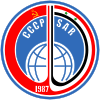 |
Delivered a third crew member, Aleksandrov, for EO-2, as well as the first Mir Intercosmos mission, EP-1, to the station. The EP-1 crew members, Viktorenko and Faris, returned to Earth aboard Soyuz TM-2 after 8 days.[4][5] |
| 4. |
Soyuz TM-4 |
21 December 1987
11:18:03 |
~177 days |
17 June 1988
10:12:32 |
 Vladimir Titov Vladimir Titov
 Musa Manarov Musa Manarov
 Anatoli Levchenko Anatoli Levchenko
|
|
 |
Delivered the third expedition crew, EO-3, to Mir, in addition to Anatoli Levchenko, who returned to Earth aboard Soyuz TM-3 with the returning EO-2 crewmembers after 8 days.[4][5] |
| 5. |
Soyuz TM-5 |
7 June 1988
14:03:13 |
~90 days |
7 September 1988
00:49:38 |
 Anatoly Solovyev Anatoly Solovyev
 Viktor Savinykh Viktor Savinykh
 Aleksandr Aleksandrov Aleksandr Aleksandrov
|
|
 |
Delivered the second Mir Intercosmos mission, EP-2, to the station. All three crew returned to Earth aboard Soyuz TM-4 after 10 days.[4][5] |
| 6. |
Soyuz TM-6 |
29 August 1988
04:23:11 |
~112 days |
21 December 1988
09:57:00 |
 Valeri Polyakov Valeri Polyakov
 Vladimir Lyakhov Vladimir Lyakhov
 Abdul Ahad Mohmand Abdul Ahad Mohmand
|
|
 |
Delivered a third crew member, Polyakov, for EO-3, in addition to the third Mir Intercosmos crew, EP-3, who returned to Earth aboard Soyuz TM-5 after 9 days.[4][5] |
| 7. |
Soyuz TM-7 |
26 November 1988
15:49:34 |
~149 days |
27 April 1989
02:57:58 |
 Aleksandr Volkov Aleksandr Volkov
 Sergei Krikalev Sergei Krikalev
 Jean-Loup Chrétien Jean-Loup Chrétien
|
|
 |
Delivered the EO-4 and Aragatz crews to Mir, with Chrétien returning to Earth aboard Soyuz TM-6 after 25 days.[4][5] |
| 8. |
Soyuz TM-8 |
5 September 1989
21:38:03 |
~165 days |
19 February 1990
04:36:18 |
 Aleksandr Viktorenko Aleksandr Viktorenko
 Aleksandr Serebrov Aleksandr Serebrov
|
|
 |
Delivered the EO-5 crew to Mir.[4][5] |
| 9. |
Soyuz TM-9 |
11 February 1990
06:16:00 |
~177 days |
9 August 1990
07:33:57 |
 Anatoly Solovyev Anatoly Solovyev
 Aleksandr Balandin Aleksandr Balandin
|
|
 |
Delivered the EO-6 crew to Mir.[4][5] |
| 10. |
Soyuz TM-10 |
1 August 1990
09:32:21 |
~129 days |
10 December 1990
06:08:12 |
 Gennadi Manakov Gennadi Manakov
 Gennady Strekalov Gennady Strekalov
|
|
 |
Delivered the EO-7 crew to Mir.[4][5] |
| 11. |
Soyuz TM-11 |
1 December 1990
08:13:32 |
~173 days |
26 May 1991
10:04:13 |
 Viktor Afanasyev Viktor Afanasyev
 Musa Manarov Musa Manarov
  Toyohiro Akiyama Toyohiro Akiyama
|
|
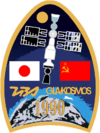 |
Delivered the EO-8 crew to Mir, in addition to the Japanese Kosmoreporter mission. Akiyama, who became the first Japanese citizen to fly in space, returned to Earth aboard Soyuz TM-10 after 8 days.[4][5] |
| 12. |
Soyuz TM-12 |
18 May 1991
12:50:28 |
~142 days |
10 October 1991
04:12:18 |
 Anatoly Artsebarsky Anatoly Artsebarsky
 / /  Sergei Krikalev Sergei Krikalev
 Helen Sharman Helen Sharman
|
|
 |
Delivered the EO-9 crew to Mir, in addition to the British Project Juno mission. Sharman, the first Briton to travel into space whilst not holding American citizenship, returned to Earth aboard Soyuz TM-11 after 8 days.[4][5] |
| 13. |
Soyuz TM-13 |
2 October 1991
05:59:38 |
~173 days |
25 March 1992
08:51:22 |
 / /  Aleksandr Volkov Aleksandr Volkov
 Toktar Aubakirov Toktar Aubakirov
 Franz Viehböck Franz Viehböck
|
|
 |
The last crewed spaceflight ever launched by the Soviet Union, Soyuz TM-13 delivered a third crew member to Mir for EO-10, in addition to carrying the first Austrian to go into space as part of the Austromir '91 mission. Aubakirov and Viehböck returned to Earth aboard Soyuz TMA-12 after 8 days.[4][5] |
| 14. |
Soyuz TM-14 |
17 March 1992
10:54:30 |
~143 days |
10 August 1992
01:05:02 |
 Aleksandr Viktorenko Aleksandr Viktorenko
 Aleksandr Kaleri Aleksandr Kaleri
 Klaus-Dietrich Flade Klaus-Dietrich Flade
|
|
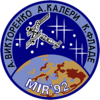 |
The first crewed spaceflight to be launched by the Russian Federation, Soyuz TM-14 delivered the EO-11 crew to Mir, in addition to Flade, flying the German Mir '92 mission, who returned to Earth aboard Soyuz TM-13 after 8 days.[4][5] |
| 15. |
Soyuz TM-15 |
27 July 1992
06:08:42 |
~187 days |
1 February 1993
03:49:57 |
 Anatoly Solovyev Anatoly Solovyev
 Sergei Avdeyev Sergei Avdeyev
 Michel Tognini Michel Tognini
|
|
 |
Delivered the EO-12 crew to Mir, in addition to the French Antarès mission. Tognini returned to Earth aboard Soyuz TM-14 after 14 days.[4][5] |
| 16. |
Soyuz TM-16 |
24 January 1993
05:58:05 |
~177 days |
22 July 1993
06:41:50 |
 Gennadi Manakov Gennadi Manakov
 Aleksandr Poleshchuk Aleksandr Poleshchuk
|
|
 |
Delivered the EO-13 crew to Mir. Became the only Soyuz spacecraft to dock at Kristall's distal APAS-89 port in order to check the port in preparation for the Shuttle-Mir flights which followed.[4][5] |
| 17. |
Soyuz TM-17 |
1 July 1993
14:32:58 |
~195 days |
14 January 1994
08:18:20 |
 Vasili Tsibliyev Vasili Tsibliyev
 Aleksandr Serebrov Aleksandr Serebrov
 Jean-Pierre Haigneré Jean-Pierre Haigneré
|
|
 |
Delivered the EO-14 crew to Mir, in addition to the French Altair mission. Haigneré returned to Earth aboard Soyuz TM-16 after 21 days.[4][5] |
| 18. |
Soyuz TM-18 |
8 January 1994
10:05:34 |
~180 days |
9 July 1994
10:32:35 |
 Viktor Afanasyev Viktor Afanasyev
 Yury Usachev Yury Usachev
 Valeri Polyakov Valeri Polyakov
|
|
 |
Delivered the EO-15 crew to Mir, with Polyakov remaining in space for over 437 days, the current world record for longest single spaceflight.[4][5] |
| 19. |
Soyuz TM-19 |
1 July 1994
12:24:50 |
~124 days |
4 November 1994
11:18:26 |
 Yuri Malenchenko Yuri Malenchenko
 Talgat Musabayev Talgat Musabayev
|
|
 |
Delivered the EO-16 crew to Mir.[4][5] |
| 20. |
Soyuz TM-20 |
3 October 1994
22:42:30 |
~166 days |
22 March 1995
04:04:05 |
 Aleksandr Viktorenko Aleksandr Viktorenko
 Yelena Kondakova Yelena Kondakova
 Ulf Merbold Ulf Merbold
|
|
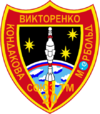 |
Delivered the EO-17 crew to Mir, in addition to the German Euromir '94 mission. Merbold returned to Earth aboard Soyuz TM-19 after 32 days.[4][5] |
| 21. |
Soyuz TM-21 |
14 March 1995
06:11:34 |
~179 days |
11 September 1995
06:52:40 |
 Vladimir Dezhurov Vladimir Dezhurov
 Gennady Strekalov Gennady Strekalov
 Norman E. Thagard Norman E. Thagard
|
 |
 |
Delivered the EO-18 crew to Mir, including Thagard, flying the first US long-duration mission of the Shuttle-Mir programme. The entire crew returned to Earth aboard Space Shuttle Atlantis at the conclusion of STS-71.[4][5] |
| 22. |
STS-71
Atlantis |
27 June 1995 |
4 days, 22 hours |
|
 Robert L. Gibson Robert L. Gibson
 Charles J. Precourt Charles J. Precourt
 Ellen S. Baker Ellen S. Baker
 Bonnie J. Dunbar Bonnie J. Dunbar
 Gregory J. Harbaugh Gregory J. Harbaugh
 Anatoly Solovyev Anatoly Solovyev
 Nikolai Budarin Nikolai Budarin
|
 |
 |
Delivered Mir EO-19 crew
Returned Mir EO-18 crew |
| 23. |
Soyuz TM-22 |
3 September 1995
09:00:23 |
~177 days |
29 February 1996
10:42:08 |
 Yuri Gidzenko Yuri Gidzenko
 Sergei Avdeyev Sergei Avdeyev
 Thomas Reiter Thomas Reiter
|
|
 |
Delivered the EO-20 crew to Mir, including the German Euromir '95 mission.[4][5] |
| 24. |
STS-74
Atlantis |
12 November 1995 |
3 days, 2 hours |
|
 Kenneth D. Cameron Kenneth D. Cameron
 James D. Halsell James D. Halsell
 Jerry L. Ross Jerry L. Ross
 William S. McArthur William S. McArthur
 Chris A. Hadfield Chris A. Hadfield
|
 |
 |
Delivered Mir Docking Module & Solar Array Package |
| 25. |
Soyuz TM-23 |
21 February 1996
12:34:05 |
~192 days |
2 September 1996
07:41:40 |
 Yuri Onufrienko Yuri Onufrienko
 Yury Usachev Yury Usachev
|
|
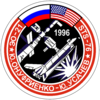 |
Delivered the EO-21 crew to Mir.[4][5] |
| 26. |
STS-76
Atlantis |
22 March 1996 |
4 days, 23 hours |
|
 Kevin P. Chilton Kevin P. Chilton
 Richard A. Searfoss Richard A. Searfoss
 Linda M. Godwin Linda M. Godwin
 Michael R. Clifford Michael R. Clifford
 Ronald M. Sega Ronald M. Sega
 Shannon W. Lucid Shannon W. Lucid
|
 |
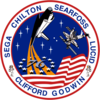 |
Delivered Lucid for Mir EO-21 crew
Deployed MEEP
1 spacewalk |
| 27. |
Soyuz TM-24 |
17 August 1996
13:18:03 |
~195 days |
2 March 1997
06:44:16 |
 Valery Korzun Valery Korzun
 Aleksandr Kaleri Aleksandr Kaleri
 Claudie Haigneré Claudie Haigneré
|
|
 |
Delivered the EO-21 crew to Mir. Haigneré returned to Earth aboard Soyuz TM-23 after 16 days.[4][5] |
| 28. |
STS-79
Atlantis |
16 September 1996 |
4 days, 22 hours |
|
 William F. Readdy William F. Readdy
 Terrence W. Wilcutt Terrence W. Wilcutt
 Thomas D. Akers Thomas D. Akers
 Jerome Apt Jerome Apt
 Carl E. Walz Carl E. Walz
 John E. Blaha John E. Blaha
|
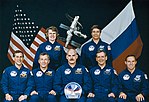 |
 |
Delivered Blaha for Mir EO-22 crew |
| 29. |
STS-81
Atlantis |
12 January 1997 |
4 days, 22 hours |
|
 Michael A. Baker Michael A. Baker
 Brent W. Jett Brent W. Jett
 John M. Grunsfeld John M. Grunsfeld
 Marsha S. Ivins Marsha S. Ivins
 Peter J.K. Wisoff Peter J.K. Wisoff
 Jerry M. Linenger Jerry M. Linenger
|
 |
 |
Delivered Linenger for Mir EO-22 crew |
| 30. |
Soyuz TM-25 |
10 February 1997
14:09:30 |
~183 days |
14 August 1997
12:17:10 |
 Vasili Tsibliyev Vasili Tsibliyev
 Aleksandr Lazutkin Aleksandr Lazutkin
 Reinhold Ewald Reinhold Ewald
|
|
 |
Delivered the EO-23 crew to Mir. Ewald returned to Earth aboard Soyuz TM-24 after 20 days.[4][5] |
| 31. |
STS-84
Atlantis |
15 May 1997 |
4 days, 23 hours |
|
 Charles J. Precourt Charles J. Precourt
 Eileen M. Collins Eileen M. Collins
 Carlos I. Noriega Carlos I. Noriega
 Edward T. Lu Edward T. Lu
 Jean-François Clervoy Jean-François Clervoy
 Yelena Kondakova Yelena Kondakova
 Michael Foale Michael Foale
|
 |
 |
Delivered Foale for Mir EO-23 crew |
| 32. |
Soyuz TM-26 |
5 August 1997
15:35:54 |
~196 days |
19 February 1998
09:10:30 |
 Anatoly Solovyev Anatoly Solovyev
 Pavel Vinogradov Pavel Vinogradov
|
|
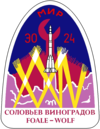 |
Delivered the EO-24 crew to Mir.[4][5] |
| 33. |
STS-86
Atlantis |
27 September 1997 |
5 days, 22 hours |
|
 James D. Wetherbee James D. Wetherbee
 Michael J. Bloomfield Michael J. Bloomfield
 Scott E. Parazynski Scott E. Parazynski
 Wendy B. Lawrence Wendy B. Lawrence
 Jean-Loup Chrétien Jean-Loup Chrétien
 Vladimir Titov Vladimir Titov
 David A. Wolf David A. Wolf
|
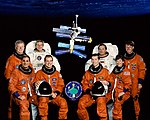 |
 |
Delivered Wolf for Mir EO-24 crew
Retrieved MEEP
1 spacewalk |
| 34. |
STS-89
Endeavour |
22 January 1998 |
4 days, 21 hours |
|
 Terrence W. Wilcutt Terrence W. Wilcutt
 Joe F. Edwards Joe F. Edwards
 Bonnie J. Dunbar Bonnie J. Dunbar
 Michael P. Anderson Michael P. Anderson
 James F. Reilly James F. Reilly
 Salizhan Sharipov Salizhan Sharipov
 Andrew S.W. Thomas Andrew S.W. Thomas
|
 |
 |
Delivered Thomas for Mir EO-24 crew |
| 35. |
Soyuz TM-27 |
29 January 1998
16:33:42 |
~206 days |
25 August 1998
05:24:44 |
 Talgat Musabayev Talgat Musabayev
 Nikolai Budarin Nikolai Budarin
|
|
 |
Delivered the EO-25 crew to Mir. |
 Léopold Eyharts Léopold Eyharts |
 |
Eyharts returned to Earth aboard Soyuz TM-26 after 22 days.[4][5] |
| 36. |
STS-91
Discovery |
2 June 1998 |
3 days, 23 hours |
|
 Charles J. Precourt Charles J. Precourt
 Dominic L. Pudwill Gorie Dominic L. Pudwill Gorie
 Wendy B. Lawrence Wendy B. Lawrence
 Franklin R. Chang-Diaz Franklin R. Chang-Diaz
 Janet L. Kavandi Janet L. Kavandi
 Valery Ryumin Valery Ryumin
|
 |
 |
Returned Thomas from Mir EO-25 crew |
| 37. |
Soyuz TM-28 |
13 August 1998
09:43:11 |
~196 days |
28 February 1999
02:14:30 |
 Gennady Padalka Gennady Padalka
 Sergei Avdeyev Sergei Avdeyev
 Yuri Baturin Yuri Baturin
|
|
 |
Delivered the EO-26 crew to Mir. Baturin returned to Earth aboard Soyuz TM-27 after 12 days.[4][5] |
| 38. |
Soyuz TM-29 |
20 February 1999
04:18:01 |
~186 days |
28 August 1999
00:34:20 |
 Viktor Afanasyev Viktor Afanasyev
 Jean-Pierre Haigneré Jean-Pierre Haigneré
 Ivan Bella Ivan Bella
|
|
 |
Delivered the EO-27 crew to Mir. Bella returned to Earth aboard Soyuz TM-28 after 8 days.[4][5] |
| 39. |
Soyuz TM-30 |
4 April 2000
05:01:29 |
~70 days |
16 June 2000
00:44 |
 Sergei Zalyotin Sergei Zalyotin
 Aleksandr Kaleri Aleksandr Kaleri
|
|
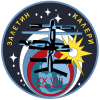 |
Final human spaceflight to Mir. Delivered the last crew, flying EO-28.[4][5] |















































